Building on the incredible success of the world’s favourite hybrid, the Prius, the Toyota Prius Plug-in Hybrid is the flagship of the Prius family.
Using the latest lithium-ion battery technology, the Prius Plug-in Hybrid provides owners with over 15 miles of zero-emissions electric-only EV driving, with the car easily recharged in just 90 minutes from a domestic 230V power supply or on-street charging location. For longer journeys, the 1.8-litre petrol engine enables the car to act as a full hybrid just like the regular Prius.
Combined fuel economy in hybrid mode is 78.5mpg, but if you take full advantage of the Prius Plug-in Hybrid’s EV capabilities, that figure shoots up to 134.5mpg – amazing results for a well-equipped, refined five-seat family car. If you need more space, then take a look at the seven-seat Toyota Prius+.
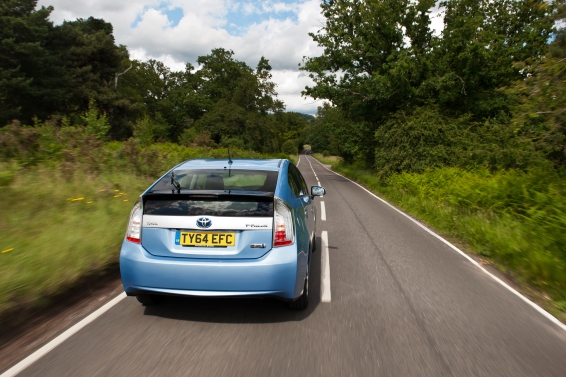
Driving
Unplug and away you go! Most urban journeys can be covered by the Prius Plug-in Hybrid’s 15.5 mile range on electric power in EV mode.
Its fully automatic CVT gearbox means that the driving experience is smooth, quiet and incredibly economical, achieving 134.5mpg on an official test designed for plug-in hybrids. Once the on-board battery begins to run low, the Prius Plug-in Hybrid seamlessly shifts into full hybrid mode, with power provided by its compact 1.8-litre VVT-i petrol engine and electric motor.
In full hybrid mode, it’s even more economical than the standard Prius – the Prius Plug-in Hybrid returns 78.5mpg as its lithium-ion battery recharges faster, meaning EV mode can be used more often. It also has three on-demand driving modes: HV for use as a full hybrid vehicle, EV for electric driving and EV-City which provides greater acceleration before the petrol engine kicks in, making it ideal for a fast-paced urban environment.
Comfort
Like the standard Prius, the Prius Plug-in Hybrid is stylish and aerodynamic on the outside, and spacious, comfortable and quiet inside. Excellent soundproofing keeps engine, wind and road noise to a minimum, especially noticeable when running in near-silent EV or EV-City modes.
The Prius Plug-in Hybrid is offered in just one trim level, which is packed with high-grade equipment including Toyota’s latest Touch & Go Plus touchscreen multimedia and navigation system, eight-speaker JBL sound system, Touch Tracer dash display that literally puts vehicle information at the tip of your fingers, with steering wheel-mounted switches.
The keyless entry and start system, means you’ll never have to search your bag for your keys, while the automatic air-conditioning with two-step heater keeps cabin temperatures constant while improving fuel economy. Heated front seats, rain-sensing wipers and cruise control further add to a cosseting, fuss-free driving experience.
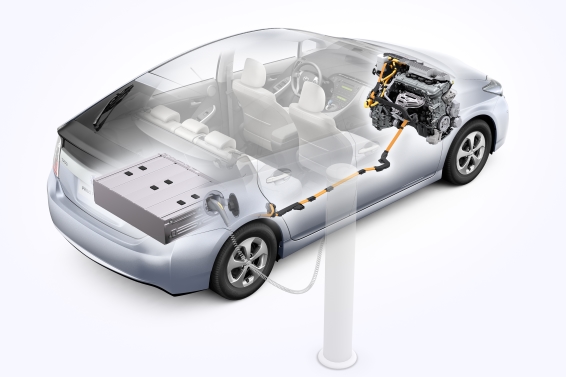
Practicality
The most practical aspect of the Prius Plug-in Hybrid is its fast recharge time – just 90 minutes at a charging point or connected to a 230V power supply will fully recharge the on-board battery ready for another 15 miles of EV driving. Yet even though the Prius Plug-in Hybrid has a greater EV range than the standard Prius, the compact design of its battery pack means that there’s no compromise in interior or boot space. With the 60/40 split rear seats in place, you have 443 litres of boot space, which increases to 1,120 litres when the rear seats are folded completely flat.
Safety
The Prius Plug-in Hybrid is built strong and equipped with seven airbags and whiplash-reducing front seats to protect and minimise injury to passengers and pedestrians in the event of an accident. But Toyota knows it is better to avoid accidents in the first place, which is why the Prius Plug-in Hybrid is fitted with anti-lock brakes with brake assist technology, traction and stability control, as well as hill-start assist.
Running Costs*
The Prius Plug-in Hybrid has unrivalled running costs for a car of its size and type. Its extended EV range reduces carbon emissions to an unprecedented 49g/km, meaning it is exempt from annual road tax charges. Fuel economy is as high as 134.5mpg (dependent on use), giving the Prius Plug-in Hybrid an achievable range of over 700 miles per tank of fuel. Maintenance costs are kept to a minimum with the Prius requiring a service every 10,000 miles or once per year.
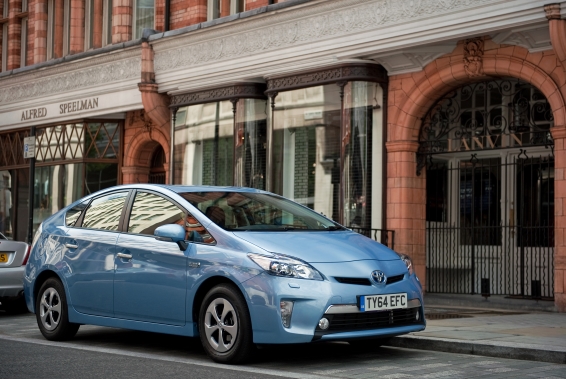
Quality
The Prius Plug-in Hybrid combines ecologically-friendly building methods and materials with Toyota’s usual high standards of quality. That’s why the Prius Plug-in Hybrid receives the same five-year/100,000 mile warranty as other Toyota cars, and the hybrid battery is covered by a separate eight-year/100,000 mile warranty as on the standard Prius. The exterior of the Prius Plug-in Hybrid is guaranteed against paint defects for three years and corrosion for 12 years, regardless of mileage.
Prices*
Buyers of the Prius Plug-in Hybrid can apply for a Government grant of up to £5,000 from the Office of Low Emissions Vehicles (OLEV), effectively reducing the on-the-road price of the Prius Plug-in Hybrid to £30,895 (£33,395 before the grant). Toyota has also partnered with British Gas and Scottish Gas (Scotland and Northern Ireland) to offer reduced rates on installation of a dedicated charging point at your home or business – prices start from as little as £375, and in some areas installation is completely free.
For further information about the Prius Plug-in Hybrid, and to arrange a test drive, visit the designated Prius Plug-in Hybrid section of the Toyota website.
*Prices correct as of 01/03/16
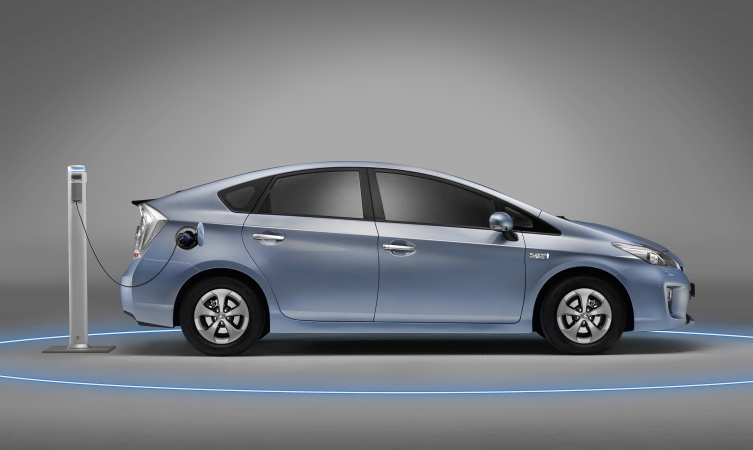
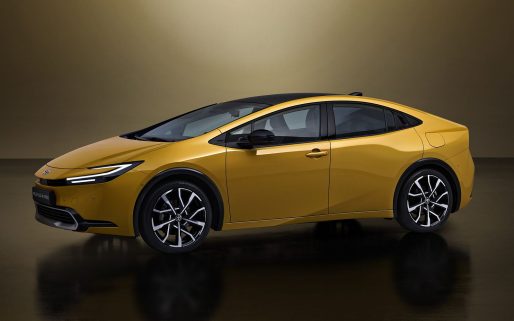
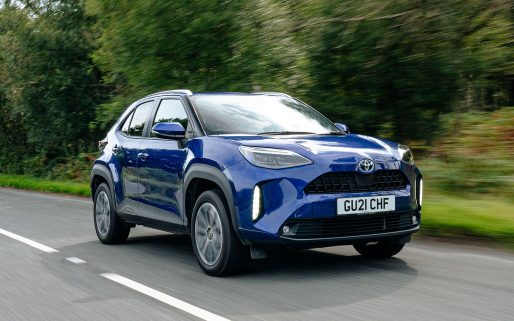

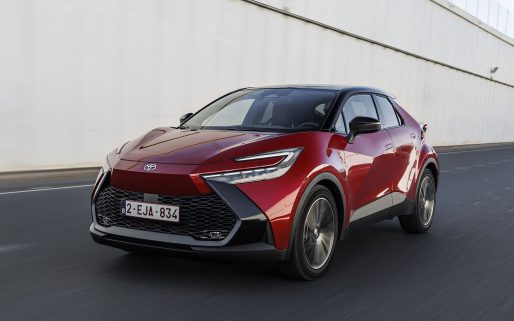
I did well over 90,000 miles in a second generation Prius – and I now have the 10th Anniversary Limited Edition 3rd Generation Prius with almost 60,000 miles on it. Both faultless and superb cars – I would have loved to have had the Prius Plug-In but it was just a little too soon for me as I changed cars around the launch date of the PHEV, so got to wait for the next car change – then it will be a Plug-In for me. Don’t believe some of the comments about fuel – as always there is an art to getting the best out of any new technology, but my last 10,000 miles were at a fuel figure of 60.7mpg. Can’t understand why anybody wouldn’t want one!
If you don’t believe me, go hire one for a week of enjoyment (1200miles!), that’s what I did before I bought the first one, and it assured me of my choice – which I have never regretted.
‘The future’s hybrid – everything else is simply ‘Priustoric’!
Hello John
Thanks for your post.
We do apprecaite your feedback regarding Prius ownership, (we are also particularly inspired by your term “Priustoric”!). We view Plug-in as the next evolution of hybrid and describe it as the best of both worlds, providing the benefits of a hybrid and electric vehicles but with none of the downsides associated with full EV’s such as range anxiety.
Thanks again for your comments.
I’d love to know when my Prius Plug-in will be “ready for another 15 miles of EV driving” [sic]. I’m lucky if my plug-in’s estimated mileage is shown to be more than 9.5 miles. And in this weather EV driving is not possible if the heater is required to demist the front window.
Perhaps I expected too much (and believed all the hype) having had 3 other Priuses …
Hello David
Thanks for your post.
Sorry to learn about your Prius Plug-in and we do have a customer relations team which can investigate vehicle concerns further. They can be reached via the attached link if this helps.
http://bit.ly/1bwxYm0
PLUG IN is not recommended to those who live outside central london and to those who live in a flat. I bought one as i got too excited with the thought of saving money, saving petrol and saving the planet but i never thought of the fact that from where i live there is only four charging points nearby and since i had my brand new Prius Plug-in, two of the closest charging points were not working, one was on a private parking space which is always in constant use and another one which i just discovered recently but unfortunately accessible only at “out of hours” as it is located in the futher end corner at the back of leisure center car park in which the two space were always occupied by ordinary cars during peak times. i tried to get in touch with the company Polar Network to apply for the home charging point, they were really quick in their response at first and promise me that they will send someone to do the installation survey and after waiting for two months i tried to call them again only to be told that because i live in the 3rd floor flat I am not eligible for the charging point installation. at the moment the only way i could charge my car is whenever i go to Westfield mall as they have a few “NOT plug-in car exclusive” charging points plus 20-30 mins of waiting for a space to be available.
The overall experience in owning a Plug-In if you live in a Flat and outside Central london?
F R U S T R A T I N G !!!!!!!!!
Hi Leo
Thanks for your post and we are sorry that you are disappointed with your Prius Plug-in Hybrid.
We do accept that careful qualification is required to be able to maximise the benefits this car can offer and we are seeing infrastructure increasing in terms of charging points along with public acceptance and awareness of this technology. You raise some valid points and we will continue to promote this technology to raise the profile and help increase the installation of these posts. Also as you point out the posts do need to be working to help owners whose vehicles require charging along with education in terms of other vehicles using these spaces.
Thank you again for taking the time to post your comments regarding ownership.
I am about to take delivery of a new Prius Plugin as a company car. Regardless of the claims over fuel econmony, as a company car driver you can’t argue with the tax saving. It has a benefit in kind rating of 5% which equates to a monthly tax bill of less than £60. Compare this to my current Audi A4 tdi at £160 per monthly. If nothing changes over the 4 years of the lease contract, then I will save £4800. But things are changing with regular car taxation increasing by 2% next year and the year after, whilst the Prius Plugin remains in the lowest bracket. It is going up to 8% BIK in a couple years but this is still way lower that regular cars.
I am expecting to make a modest saving in fuel cost over the Audi which has averages 45mpg over the last four years So all in all, I don’t see a £7000 saving over four years as unrealistic in the next four years. I will also be benefitting from the free British Gas charging point fitted recently too.
Hi Phil
Thanks for your post.
We appreciate your comments regarding the Plug-in Prius and the taxation benefits it provides. Please let us know how you get on when you take delivery and if you have any questions.
just had my first service at 10000 miles. Car is showing 78mpg average since new. The speedo is optimistic and this is more like 72mpg. 16% has been achieved by electric charging so I am averaging 61mpg on petrol.
I have a home charger and there are charging points I can use at work, Half my charging is free (work) and the home based charging is 12p per kW. I have estimated when I pay for electric it is costing me about 2.5p per mile. Petrol is 10p per mile.
For new users I thought I would share my experience of Public Charging points.
Public charging is a disaster. The free charging points from Ecotricity, Swaltrac and Pod Point do not accept the 3 pin charging cable provided by Toyota. You need the mennekes type 2 connector that Toyota charge £549 extra for. I would never be able to make a case to justify the cable as it would take me more then three years of using public points three time a week to recover the up front cost of the cable.
Chargemaster points do use three pin public charging points but are now charging the equivalent of over 50p per kW to use them, which makes it cheaper to drive on petrol.
Of my 10 attempts to use different public charging points, two have been successful, two were out of order and the rest I have not had the right cable.
I was informed by the Toyota dealership when I said I could get an after market Mennekes cable for £200, that if I used it it would invalidate the warranty.
I have a collection of 4 charge point cards and have found that I can not use them. This is very disappointing to say the least.
Regards
We also find it impossible to get the claimed 15 miles out of our Prius plugin. In fact in the year since we’ve had it the fully charged indicator has dropped from showing 11.3 to 9.3 miles range (with the air conditioning and all lights / heating OFF). Quite a degradation.
I’m actually in Jemca Bracknell waiting for it to be serviced at the moment and I’ve pointed out I’m not happy at this represents an 18% drop off in range since we had the car or a total of 28% from the brochures 15 mile claim.
They have indicated that the service includes a battery check so I’m interested in seeing if it picks a problem up. My guess is it’s not going to as they said it was checked and all was ok when we bought the car from them a year ago and we have never seen it show the full claimed range.
We drive the car really slow most of the time so I don’t buy that this is down to our ‘driving style’ unless its better of course to drive it fast and aggressive rather than carefully and slow.
Hi Glenn,
Thanks for your message. We’ve written an explanation of how the EV range display in the Prius Plug-in works below – we hope it answers your questions and reassures that everything should be working properly.
Do let us know if you have any other questions.
When a Prius Plug-in comes out of the factory, the EV Range figure will show 12.5 – 14.5 miles. The hybrid system in the Prius Plug-in has a learning function that takes into account electric mileage achieved from previous journeys. This is used alongside the remaining battery charge to calculate the EV driving range figure you see. This means the EV driving range figure on the display can go up or down depending on how you drive the car, the weather and traffic conditions and so on.
Cars that are being used in cold climate conditions where the driver requires the use of electrical accessories such as the heated rear window, heated seats, headlights, audio, wipers etc may not always succeed in achieving the EV range shown in the Multi-information Display. On the contrary, if the vehicle is being used in warmer climate conditions and the use of electrical accessories is reduced, the vehicle may exceed the EV range shown in the Multi-information Display.
For reference, the official EV driving range (15.5 miles) has been derived from tests on a chassis dynamometer using a vehicle that has completed the recommended running-in period.
The test conditions are:
Ambient temperature: 25° Celsius
Air-conditioning: Off
Electric devices such as Audio: Off
We do understand the seeing the remaining charge display can be frustrating but we hope your driving style and the warmer weather approaching will help contribute to a higher EV range.
Many thanks.